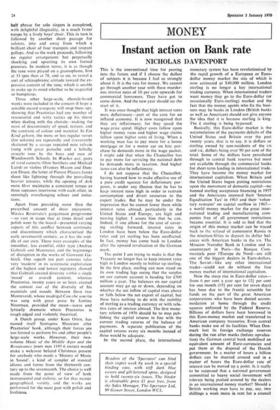MUSIC
Old master
MICHAEL NYMAN
Imagining myself immune from novelty, wrapped up against surprise in the dying em- bers of the 'sixties, I was hardly prepared to be left gasping with astonishment by, of all things, a work based on In dulci jubilo at, of all places. a Christmas concert (Queen Elizabeth Hall two weeks ago). It was not. perhaps, so surprising, since the concert was given by Musica Reservata—although the work in question was not by Stockhausen or Maxwell. Davies, but by an early seven- teenth century composer who, so far as our musical experience is concerned, doesn't even rate an II-IF (Tovey's Interesting Historical Figure).
Michael Praetorius is, however, a name to reckon with. In a quiz—with a huge amount of prize money—we might dredge up some information about him: that he in- troduced into Germany the technique of op- posing sound masses, made famous by Giovanni Gabrieli at St Mark's. Venice; that he was overshadowed by the three Ss, Schein, Scheidt and Schutz; that he was the author of the Svntagina Musicum. three in- dispensable volumes on the musical customs and instruments of the time; and that he is known to the discerning record buyer only as the composer of some entertaining but not very adventurous dances drawn from a vast collection called Terpsichore (which is something like knowing Bach only by his four-part chorale. or Mozart by his German Dances). The small print in the history books tells us that Praetorius made an important contribution to the development of works based on the Lutheran chorale, of which he himself distinguished three types: one like the imitative technique of the previous cen- tury, another presenting the tune in long notes (like a Bach chorale prelude), while the most radical, 'madrigal fashion', divides the tune up into motives among different instruments and groups.
So far so good. but this is little preparation for the shock of Praetorius' In dulci jubilo, which revealed a volatile imagination, unhampered by convention, and whose structures uncannily foreshadow the jux- taposition and collage techniques of today fnow that music has escaped from the se- quential narrative forms which it has employed day in. day out. since not long after Praetorius' time). The work sounds (though Praetorius, unlike Birtwistle, would not consciously have conceived it in this way) as though a number of different settings of the tune were going on simultaneously except that they are constantly interruptint one another.
Thus. the slow, slightly sentimental firm
half phrase for solo singers is completed, with delightful illogicality, in a much faster tempo by, a lively boys' choir. This in turn is followed by another short passage for soloists, into and away from which a brilliant choir of four trumpets and timpani gallops. And so the work proceeds, following no regular arrangement but perpetually shocking and upsetting its own formal premises. In modern terms, it is as though the tune were played on a gramophone, first at 33 rpm then at 78, and so on, to reveal a sort of schizophrenic attitude toward the ex- pressive content of the tune, which is unable to make up its mind whether to be respectful or bumptious.
Three other large-scale, chorale-based works were included in the concert (I hope a sensible record company will snap them up), showing that Praetorius had any number of resourceful and witty tactics up his sleeve when dealing with the chorale—making the most of discontinuity of speed, texture, and the contrasts of colour and material. In Ein Kind geborn, the more or less regular verses (for soloists) are repeatedly and irreverently shattered by a savage repeated note refrain (sung with great panache and a lethally straight tone by the boys and men of Wandsworth School). In Wachet auf, pairs of vivid cornetts (Don Smithers and Michael Laird) or violins (Frances Mason and Dun- can Druce, the latter of Pierrot Players fame) shoot like lightning through the prevailing heavier textures, while the opening of Ach mein Herr maintains a consistent tempo as three sopranos intertwine with each other, in seemingly everchanging echoes and imita- tions.
Apart from providing more than the prescribed amount of sheer enjoyment, Musica Reservata's gargantuan programme —so vast in scope that at times detail and polish went by the board—presented varying aspects of this conflict between continuity and discontinuity which characterised the early seventeenth century, as it has the mid- dle of our own. There were examples of the smoother, less eventful, older type (Andrea Gabrieli and Marenzio), and the beginnings of disruption in the works of Giovanni Ga- brieli. One superb ten part canzona (also very 'modern' in its systematic exploitation of the highest and lowest registers), showed that Gabrieli created diversity within a single 'mood' or overall content, whereas Praetorius, twenty years or so later, created the context out of the diversity of his materials and moods. Between these two Monteverdi, whose madrigal Con the soavita was sung with great poise by Jantina Noorman, provided the mean—suave and lyrically dramatic where Praetorius is rough-edged and violently theatrical.
A Dutch group, under Kees Otten, has named itself Syntagma Musicum after Praetorius' book, although their forces are too limited to perform his and other people's large-scale works. However, their two- volume Music of the Middle Ages and the Renaissance (HMV HQS 1195-6 stereo) would make a welcome belated Christmas. present for anybody who needs a 'History of Music in Sound', a kind of sampler of musical idioms and forms from the thirteenth cen- tury up to the seventeenth. The choice js well made from the point of view of both instrumental and stylistic, or for that matter geographical, variety, and the works are performed for the most part with polish and
liveliness.















































 Previous page
Previous page